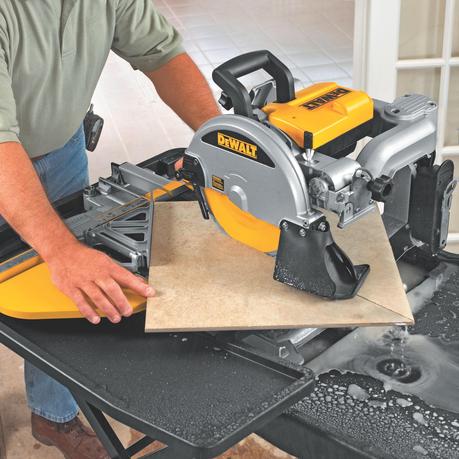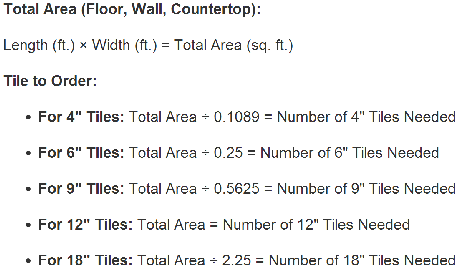Tiling a bathroom floor can be a project reserved for flooring specialists or for the DIY savvy homeowner who doesn’t mind learning a new trade over the weekend. Installing new tile in your bathroom can instantly change the dynamics of your master bathroom and give it a completely new look. Not only will you be able to appreciate the difference, it can improve the resale value of your home and home equity.
Let’s dig right in, laying bathroom tile is the easy part and the entire job will take you a few solid 8 hours days to finish. Make sure that you have between 15-22 hours set aside for your tiling project. While you’re at it, you may want to think about replacing your bath vanity with a modern bathroom vanity. Although you will need some special tools to tile your bathroom floor, you will still be able to save money rather than hiring a contractor to do it for you. Not to mention you get to keep some pretty cool toys!

Image via New House Design.
You can visit our Resource Center to find more in-depth information about installing tile here!
Tiling Supplies
Redoing your bathroom floor will require some special tools that will make the job both easier and possible. All of these supplies can be found at your local hardware stores like Home Depot, Ace Hardware, or Lowes. Here is a list of supplies you will need to tile a bathroom floor:
- Tile of your choice, grout, grout spacers, grouting squeegee.
- Wet Saw, tape measure, trowels, adhesive spreader.
- Several buckets to mix mortar, broom, dust pan, pencil, sponge, and a few extra rags.

How Much Tile Should I Purchase?
This is a pretty important decision that will likely have the largest influence on your budget. How many individual tiles you need will ultimately depend on how big your tiles are. Here is a breakdown that you can reference. If you don’t like doing math, you can visit Bank Rate and use their online “Tile Calculator.”

6 Step Do-It-Yourself Bathroom Tile Guide
1. Remove Old Floor
Begin your bathroom renovation by removing the door so that the floor is accessible. This will make your job a lot easier in the long run so don’t skip this step. When removing existing flooring, make sure that you extract ALL pieces. Maintain a clean work space to prevent debris and small particles from adding clutter to your work area. You will need a flat surface in order for your new tile flooring to come out the way you plan.
Use a leveler to make sure that the existing foundation is flat across all surfaces. A slightly elevated area can cause major problems when laying tile. Not only will your floor be uneven, it can throw off your measurements. A quick trick to that will make your life easier is self-leveling concrete. All you have to do is pour out some concrete and it will even out the existing sub-floor by filling in cracks and settling in lowered areas.
2. Prepping the Floor
Once you have removed any sign of the previous flooring, sweep your bathroom with a broom to make sure that there is no dust or debris remaining. If the floor is not clean, the tile adhesive will not bond correctly with the floor. Take 15 minutes or so do some light cleaning to prep your floor.
3. Lay Out Tiles
Before your stick your tiles to the floor permanently, lay out the entire floor with custom fit tile so that you can make sure everything will fit. Use grout spacers to ensure that a uniform gap is left between each tile. This will give you a good idea of how all of the pieces of the puzzle will fit together.
Using your wet saw, trim pieces of tile for corners and areas that go around your toilet base. Take your time because this is one of the most important steps. How your tile lays out will show you what your bathroom will look like when it is complete. If you notice small imperfections or a piece of tile that wasn’t cut correctly, go over and replace this section. It will make a big difference when you finish!

Image via Gracie Pi.
4. Mix Mortar
You will want to pick up a bag of thin set from the local hardware store. Thinset is an adhesive mortar made out of cement and sand. When mixed with water, this combination creates an adhesive used to attach tile and stones. Depending on the specifications of the brand you purchased, you will need to pour in thinset and mix it with water until you reach the proper texture.
5. Begin Tiling
Now that you have your tiles all cut out and your thinset ready to go, you can begin the actual tiling process. Use an adhesive spreader to apply the thinset to the floor, running the teethed edges along the floor to make sure that you get an even spread. Don’t do the entire bathroom floor at once because the thinset can dry. Try spreading your thinset one row at a time make sure that you have enough time to lay the tile before the compound dries.
When laying your bathroom tile, set spacers at each corner of the tile to make sure that your grout lines come out straight. When you are positive that it is in the right location, you will want to apply a little pressure to the tile to make good contact with the adhesive. You don’t need to strain your body to make it stick, just enough to make a create a good seal.

6. Grout Tile & Add the Finishing Touches
Allow 24-36 hours for your tile to dry. Grout goes in between each piece of tile. This is what creates the parallel lines in tile flooring. Grout also prevents cracking that is sometimes caused by tile expanding and contracting as a result of changes in temperature. Simply lay your grout in between and use a sponge to wipe away any excess grout. When you are satisfied with your end result, let the grout stand overnight so that it can dry. Need more help?
Tradewinds Imports is the web’s premiere source for luxury modern bathroom vanities. To learn more about our products, you can Visit Our Homepage. You can also learn more about Bathroom Renovation by browsing through out How-To section.
About this Post
Cheryl Khan is a contributor to the Tradewinds Imports Blog. She enjoys sharing her knowledge with online web browsers by writing and interacting with others on Houzz and in various home renovation communities! Ask her a question about this post by tweeting her @SuperInteriors!

